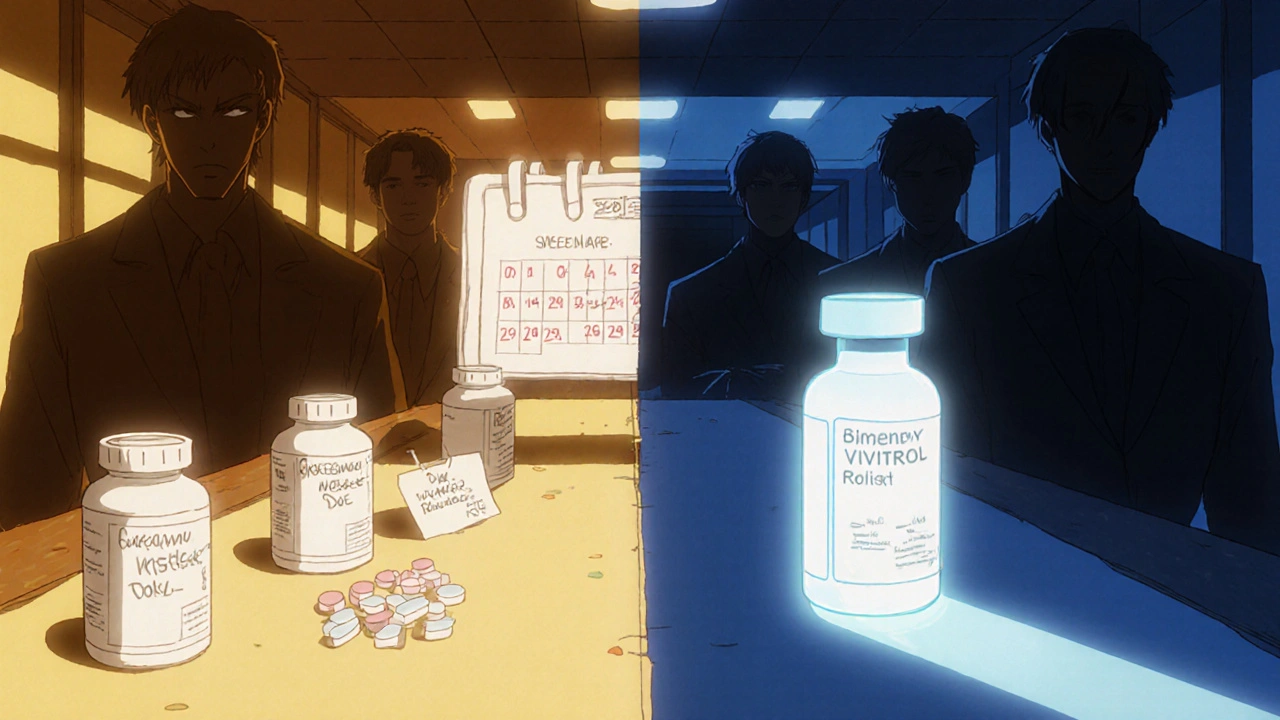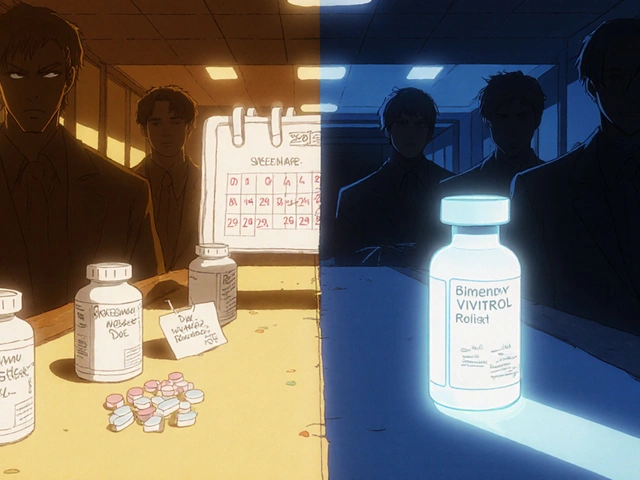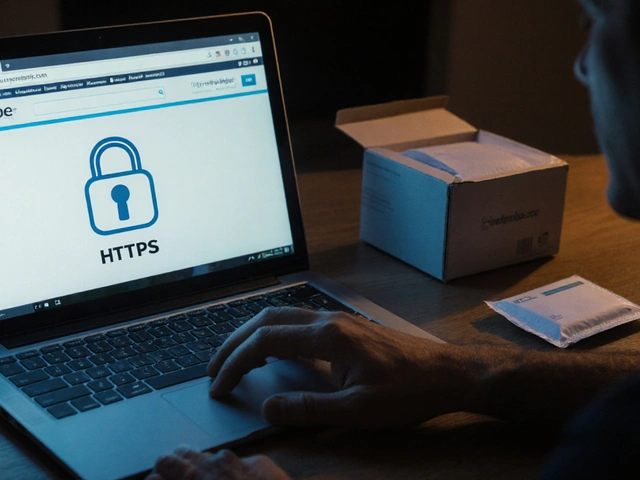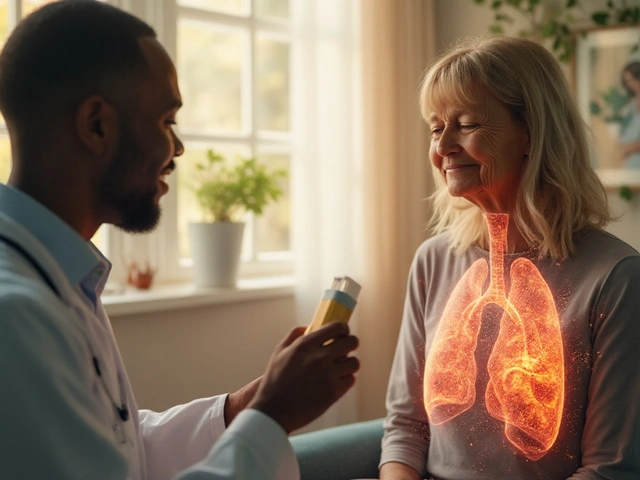Medication Selection Guide for Alcohol and Opioid Dependence
Do you have alcohol dependence only?
Do you have opioid dependence only?
Are you currently using substances?
What's your primary goal?
How well can you stick to a daily schedule?
When someone is trying to break free from alcohol or opioid dependence, the right medication can make all the difference. Naltrexone hydrochloride-often just called naltrexone-is one of the most studied drugs for this purpose. But it’s not the only option. Many people wonder: Is naltrexone the best choice? Or are there better alternatives out there? The answer isn’t simple. It depends on your goals, your body, and what kind of support you have around you.
What is Naltrexone Hydrochloride?
Naltrexone hydrochloride is a prescription medication that blocks opioid receptors in the brain, reducing cravings and preventing the euphoric effects of alcohol and opioids. It was first approved by the FDA in 1984 for opioid dependence, and later for alcohol use disorder in 1995. It comes in two forms: a daily oral tablet and a monthly injectable called Vivitrol.
Unlike methadone or buprenorphine, naltrexone doesn’t activate opioid receptors. It doesn’t cause dependence or withdrawal when stopped. That makes it safer for people who want to avoid replacing one addiction with another. But it also means you must be completely detoxed before starting-otherwise, it can trigger sudden, severe withdrawal.
Studies show naltrexone reduces heavy drinking days by about 25% and lowers relapse rates in opioid users by up to 50% when taken consistently. But here’s the catch: it only works if you take it. Missing doses means it loses effectiveness. That’s where alternatives come in.
Alternative 1: Vivitrol (Extended-Release Naltrexone)
Vivitrol is the injectable version of naltrexone. Instead of swallowing a pill every day, you get a shot once a month in a doctor’s office. This removes the need for daily discipline. For someone who struggles with routine or has a history of forgetting meds, Vivitrol can be a game-changer.
It delivers the same active ingredient as the tablet-naltrexone-but keeps blood levels steady for 28 days. Clinical trials found that people on Vivitrol were 1.5 times more likely to stay in treatment than those on placebo. In one 6-month study, 36% of Vivitrol users remained abstinent from alcohol, compared to 23% on placebo.
The downside? It’s expensive-often over $1,000 per injection without insurance. It also requires full detox before the first shot. And if you relapse and use opioids after the injection wears off, your tolerance may be lower, raising the risk of overdose.
Alternative 2: Campral (Acamprosate)
Campral, or acamprosate, is designed specifically for alcohol dependence. It doesn’t block cravings like naltrexone. Instead, it helps stabilize brain chemistry after someone stops drinking. Think of it as a calming agent for the nervous system.
It works best for people who have already quit drinking and are trying to stay sober. Unlike naltrexone, you don’t need to be detoxed first. You can start Campral while still drinking, though it’s most effective after abstinence begins.
Research shows Campral increases the chance of staying abstinent by about 10-15% over placebo. In one large trial, 34% of people on Campral stayed sober for 6 months, compared to 23% on placebo. It’s generally well-tolerated-common side effects include diarrhea and mild stomach upset.
But Campral doesn’t touch opioid cravings. If someone has both alcohol and opioid dependence, it’s not enough on its own. Naltrexone covers both, while Campral only handles alcohol.
Alternative 3: Suboxone (Buprenorphine/Naloxone)
Suboxone is the go-to for opioid dependence, especially for people still using or struggling with withdrawal. It contains buprenorphine, a partial opioid agonist, and naloxone, which prevents misuse if injected.
Unlike naltrexone, Suboxone activates opioid receptors-just not as strongly as heroin or fentanyl. This reduces cravings and withdrawal without causing a high. It’s often used long-term, sometimes for years.
Studies show Suboxone is more effective than placebo and often more effective than naltrexone for keeping people in treatment. One 2023 meta-analysis found that 68% of people stayed on Suboxone after 6 months, compared to only 42% on naltrexone.
But Suboxone isn’t for everyone. It carries a risk of dependence. You can’t switch from Suboxone to naltrexone without a full detox. And it’s not approved for alcohol use disorder alone. If your main problem is drinking, not opioids, Suboxone isn’t the right fit.

Alternative 4: Topiramate and Gabapentin
These aren’t FDA-approved for alcohol dependence, but doctors prescribe them off-label all the time. Topiramate, originally an anti-seizure drug, has been shown in clinical trials to reduce alcohol cravings and heavy drinking. One study found it cut heavy drinking days by 40%-better than naltrexone in some cases.
Gabapentin, another anti-seizure medication, helps with sleep and anxiety during early recovery. It’s especially useful for people who drink to cope with stress or insomnia. A 2022 trial showed Gabapentin improved abstinence rates by 27% over 12 weeks.
Neither drug blocks opioid receptors, so they don’t help with opioid dependence. But for alcohol-only cases, they’re viable options, especially if naltrexone causes nausea or doesn’t work. Side effects include dizziness, brain fog, and tingling in hands or feet.
Alternative 5: Behavioral Therapy + Support Groups
Medication isn’t the whole story. Even the best drug won’t work without support. Cognitive Behavioral Therapy (CBT), Motivational Enhancement Therapy (MET), and 12-step programs like Alcoholics Anonymous (AA) are proven to boost outcomes.
One major study found that combining naltrexone with weekly CBT doubled the chance of staying sober for a year compared to medication alone. The same holds true for Vivitrol and Campral. Medication helps manage biology. Therapy helps change behavior.
Many people who quit drinking or using opioids relapse because they didn’t address the triggers-stress, trauma, loneliness, boredom. No pill fixes that. That’s why combining medication with counseling is the gold standard.
Which One Should You Choose?
There’s no universal best option. Your choice depends on your situation:
- If you’re still using opioids or alcohol and need help managing withdrawal → Suboxone is likely your best bet.
- If you’ve detoxed and want to prevent relapse, especially with both alcohol and opioids → Naltrexone (oral or Vivitrol) is ideal.
- If your main issue is alcohol and you’ve already stopped drinking → Campral might be gentler and easier to tolerate.
- If naltrexone gives you nausea or doesn’t help → try Topiramate or Gabapentin as off-label options.
- If you struggle with daily pills → Vivitrol removes that barrier.
- If you’re not ready for medication → start with therapy and support groups. They’re free, accessible, and life-changing.
Some people use more than one. For example, someone might take Vivitrol to block cravings and attend AA meetings to build a support network. Others use Campral for alcohol and naltrexone for opioid triggers. It’s not one-size-fits-all.

What Doesn’t Work
Don’t expect miracles. Naltrexone won’t make you stop drinking if you’re not ready. Vivitrol won’t fix your relationships. Campral won’t erase trauma. Medication is a tool-not a cure.
Also, avoid self-medicating. Buying naltrexone online or using someone else’s prescription is dangerous. Dosing matters. Interactions matter. You need medical supervision.
And don’t quit cold turkey without help. Withdrawal from alcohol or opioids can be deadly. Always work with a doctor or addiction specialist.
Real-Life Outcomes
Take Maria, 42, from Brisbane. She’d been drinking for 15 years. After two hospitalizations for alcohol poisoning, she tried naltrexone tablets. She forgot to take them. After three months, she relapsed. Her doctor switched her to Vivitrol. She got the shot every 4 weeks. Within 6 months, she was sober. She started therapy. Now she volunteers at a recovery center.
Then there’s James, 31. He was using opioids and alcohol. He tried naltrexone but couldn’t get detoxed. His doctor put him on Suboxone. He stabilized. He stopped drinking. He’s been clean for 2 years. He doesn’t need naltrexone-he needed buprenorphine.
There’s no single hero drug. The right choice is the one that fits your life, your history, and your readiness to change.
Can I take naltrexone if I’m still drinking?
No. Naltrexone can cause sudden, severe withdrawal if you’re still using opioids or heavy alcohol. You must be fully detoxed for at least 7-10 days before starting. Your doctor will test you to confirm you’re clean.
Is Vivitrol better than naltrexone tablets?
It depends. Vivitrol removes the need for daily pills, which helps people who struggle with adherence. But it’s more expensive and requires monthly doctor visits. Tablets are cheaper and more flexible. Both are equally effective if taken correctly. Vivitrol wins for consistency; tablets win for cost and control.
Can naltrexone help with opioid cravings?
Yes. Naltrexone blocks opioid receptors, so if you use heroin, fentanyl, or prescription painkillers while on it, you won’t feel high. This reduces the reward of using and helps break the cycle of addiction. It’s approved for both alcohol and opioid dependence.
How long should I take naltrexone or its alternatives?
There’s no fixed timeline. Many people take it for 6-12 months. Some stay on it for years. The goal is to build new habits and reduce triggers. Stopping too early increases relapse risk. Talk to your doctor about your progress before deciding to stop.
Are there natural alternatives to naltrexone?
No proven natural alternatives exist. Supplements like kudzu, baclofen, or milk thistle are sometimes marketed, but none have strong clinical proof. FDA-approved medications are the only ones shown to reliably reduce cravings and relapse. Natural doesn’t mean safe or effective.
What if naltrexone makes me feel sick?
Nausea is common at first, especially with the tablet. Taking it with food or at night helps. If it doesn’t improve in a week, talk to your doctor. You might switch to Vivitrol, try Campral, or explore Topiramate. Don’t quit without guidance-you might be giving up on something that could work.
Next Steps
If you’re considering treatment, start by talking to your doctor or an addiction specialist. Bring a list of what you’ve tried, what worked, and what didn’t. Ask about testing for liver function, kidney health, and mental health conditions-these affect what medications are safe for you.
Don’t wait for the perfect plan. Start with one step: a consultation, a blood test, a therapy session. Progress isn’t linear. Relapse isn’t failure. The goal isn’t perfection-it’s progress.
There’s no shame in needing help. Millions of people use naltrexone and its alternatives to rebuild their lives. You’re not alone. And with the right support, recovery is possible.








Comments
bro naltrexone is just a bandaid tbh i tried it n kept forgettin to take it like a total mess lol
Really appreciate how you laid out the options here - especially highlighting that meds aren’t magic. I’ve seen people think popping a pill = cured, then get frustrated when life still sucks. Therapy + meds? That’s the real combo. Also, shoutout to Vivitrol for people who can’t manage daily pills - game changer for my cousin.
Campral is underrated. I was on naltrexone for months and got zero results. Switched to Campral after 3 weeks sober - no nausea, no brain fog, just steady calm. Took me 6 months to believe it was working but now I’m 2 years clean. Don’t give up if one drug fails you. Try another.
Also - if you’re still drinking, don’t wait for perfection. Start therapy today. Even one session helps.
Topiramate? Really? That stuff gives you brain fog so bad you forget your own name. I took it for 3 weeks and couldn’t even spell ‘alcohol’ correctly. Also why are you even recommending off-label drugs like that? This isn’t a supplement forum. Stick to FDA-approved stuff unless you’re a doctor with a death wish.
Ohhhh sweet mercy - Vivitrol costs OVER A THOUSAND DOLLARS?!?!!? And you expect working-class folks to just… *snap fingers*… afford that?!?!!? Meanwhile, Suboxone is covered by Medicaid and you’re out here comparing it to some fancy injectable that only rich people can access?!?!!? This post reads like a pharma ad written by a guy who thinks ‘detox’ is a Netflix documentary.
Also - ‘natural alternatives don’t work’? LOL. Kudzu has been used in Ayurveda for centuries. You’re not a scientist. You’re a marketing bot.
YOU GOT THIS. Seriously. Whether it’s naltrexone, Campral, or just showing up to a meeting - you’re already winning. Progress isn’t about being perfect. It’s about showing up. Even if you miss a dose. Even if you slip. You’re still fighting. And that’s what matters. Keep going. We’re rooting for you.
So let me get this straight - you’re telling me the ‘best’ option is a $1000/month shot that requires you to be completely clean BEFORE you start… but if you relapse after it wears off, you might OD? 😭
That’s not treatment. That’s a death trap wrapped in a medical brochure. And you call that ‘gold standard’? 😂
Meanwhile, Suboxone lets you live your life, work, parent, be human - and it’s CHEAPER. This whole post feels like a corporate pamphlet from a pharma exec who’s never met someone who’s actually struggling.
It is imperative to underscore that pharmacological interventions, while efficacious, must be contextualized within a comprehensive, multidisciplinary framework of care. The assertion that medication alone constitutes a therapeutic solution is both empirically unsound and ethically precarious. Clinical evidence consistently demonstrates that sustained recovery is contingent upon the synergistic integration of psychosocial support, behavioral modification, and medical oversight. To reduce this complex, biopsychosocial phenomenon to a pharmacological hierarchy is to misunderstand the very nature of addiction. One must not conflate mechanism of action with outcome efficacy. The patient’s autonomy, lived experience, and environmental determinants remain paramount. Consultation with a licensed clinician is not merely advisable - it is non-negotiable.